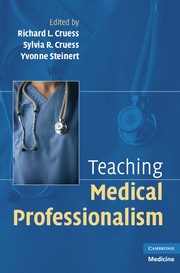Book contents
- Frontmatter
- Contents
- List of Contributors
- Foreword by William M. Sullivan
- Introduction
- PART ONE WHAT IS TO BE TAUGHT
- PART TWO THEORY
- PART THREE PRINCIPLES
- 4 Principles for Designing a Program for the Teaching and Learning of Professionalism at the Undergraduate Level
- 5 Resident Formation – A Journey to Authenticity: Designing a Residency Program That Educes Professionalism
- 6 Supporting Teaching and Learning of Professionalism – Changing the Educational Environment and Students' “Navigational Skills”
- 7 Assessment and Remediation in Programs of Teaching Professionalism
- 8 Developing Professionalism across the Generations
- 9 Faculty Development for Teaching and Learning Professionalism
- 10 The Relationship between Teaching Professionalism and Licensing and Accrediting Bodies
- 11 Educating the Public about Professionalism: From Rhetoric to Reality
- PART FOUR PRACTICE: CASE STUDIES IN TEACHING PROFESSIONALISM ACROSS THE CONTINUUM
- APPENDIX A Definitions of Professionalism
- APPENDIX B Core Attributes of Professionalism
- APPENDIX C The Teaching of Professionalism: Vignettes for Discussion
- APPENDIX D A Matrix for “Matching” Teaching Methods to Attributes
- APPENDIX E Sample Grid for Use with Discussion of Vignettes
- APPENDIX F Sample Questions to Guide Discussion about the Social Contract: Small-Group Leaders' Guide with Suggested Responses
- APPENDIX G Professionalism Program for Residents: Suggested Outline for Small Group Facilitators
- APPENDIX H Sample Evaluation Form for Residents' Half-Day Program on Professionalism
- Index
- References
8 - Developing Professionalism across the Generations
Published online by Cambridge University Press: 01 September 2009
- Frontmatter
- Contents
- List of Contributors
- Foreword by William M. Sullivan
- Introduction
- PART ONE WHAT IS TO BE TAUGHT
- PART TWO THEORY
- PART THREE PRINCIPLES
- 4 Principles for Designing a Program for the Teaching and Learning of Professionalism at the Undergraduate Level
- 5 Resident Formation – A Journey to Authenticity: Designing a Residency Program That Educes Professionalism
- 6 Supporting Teaching and Learning of Professionalism – Changing the Educational Environment and Students' “Navigational Skills”
- 7 Assessment and Remediation in Programs of Teaching Professionalism
- 8 Developing Professionalism across the Generations
- 9 Faculty Development for Teaching and Learning Professionalism
- 10 The Relationship between Teaching Professionalism and Licensing and Accrediting Bodies
- 11 Educating the Public about Professionalism: From Rhetoric to Reality
- PART FOUR PRACTICE: CASE STUDIES IN TEACHING PROFESSIONALISM ACROSS THE CONTINUUM
- APPENDIX A Definitions of Professionalism
- APPENDIX B Core Attributes of Professionalism
- APPENDIX C The Teaching of Professionalism: Vignettes for Discussion
- APPENDIX D A Matrix for “Matching” Teaching Methods to Attributes
- APPENDIX E Sample Grid for Use with Discussion of Vignettes
- APPENDIX F Sample Questions to Guide Discussion about the Social Contract: Small-Group Leaders' Guide with Suggested Responses
- APPENDIX G Professionalism Program for Residents: Suggested Outline for Small Group Facilitators
- APPENDIX H Sample Evaluation Form for Residents' Half-Day Program on Professionalism
- Index
- References
Summary
Maintaining, strengthening, and renewing professionalism is a responsibility for each generation of physicians. Medical professionalism has been called a dynamic social contract derived from the interaction of many influences such as the tradition of healing, and scientific advances, society's needs and resources, cultural norms and major events, as well as the interests of members of the profession. There are increasing calls for medicine to renew its professionalism and creatively adapt to social changes. Over the past decade, the medical literature has evinced a growing interest in professionalism. This has concentrated largely on educating students and residents. This focus on the newest members of the profession has brought to the forefront the existence of a generation gap in professional values between senior physicians and trainees. Medical administrators and recruiters are also calling for greater efforts to bridge generational differences in the workplace to maximize productivity of this new cohort of physicians.
Professionalism, reflective of the social contract between physicians and society, should be constantly reflected upon, renewed, and reaffirmed for existing members of the profession and developed for its newest members. One of the great challenges for the twenty-first-century medical profession is to adapt to internal and external changes and to influence the values of its members. Fostering shared yet continually developing values in an increasingly diverse profession and rapidly changing social and health care environment is a daunting task.
- Type
- Chapter
- Information
- Teaching Medical Professionalism , pp. 150 - 164Publisher: Cambridge University PressPrint publication year: 2008



